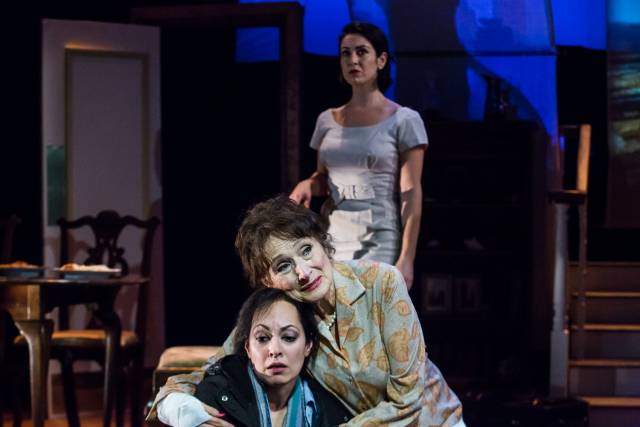

This Time is dedicated to the memory of Suzy Coates, also known as Amal Meguid, the woman whose memoir Not So Long Ago, inspired playwright Sevan K. Greene to tell her story onstage. Upon arriving to the Sheen Center Blackbox you are welcomed by photographs and letters of Ms. Meguid, looking all the part a Golden Age movie star, with big, expressive eyes and the kind of poise one simply is born with. One look at the image and it’s no wonder why Greene was so compelled to tell her story, this woman needed to be shared with the world.
What’s curious is that he decided to turn her tale into a ghost story, in which non-supernatural apparitions haunt the lives of two women: the older Amal (Delphi Harrington) and her middle aged daughter Janine (Salma Shaw). In the best theatrical tradition the women are forced to live together, when the daughter takes in the mother who has broken her arm and will be helpless on her own. Following theatrical standard, they also discover that living together will be the ideal occasion to make some emotional spring cleaning, as Janine confronts her mother for abandoning her children when they were little, and the mother finding every moment ideal to pick on her daughter’s flaws.
Through Amal’s “visions” we learn of her past as a young married woman (Rendah Heywood) in 1960s Egypt, and how she fell in love with a handsome, charming, but eventually disappointing Canadian professor called Nick (Seth Moore). The ghosts follow Amal everywhere, suggesting inevitable dementia, but also deep regret and sorrow.
Janine’s home - a beautiful set by David Esler - serves as the playground for characters in the present and the past, which at times makes for very awkward staging, since elements like a big black cordless phone stick out like a sore thumb in scenes set in the past. One wonders if the script specified a single set, or if director Kareem Fahmy had to make his best with what the production allowed. The blocking at times flows beautifully (there is a scene where the four characters share a meal that’s quite the feat of line delivery), but at times the scenes just have an odd feeling to them, as if the need for creative blocking got in the way of the play.
It’s important to note how great the casting of both versions of Amal is. Ms. Heywood brings an air of effortless class and sophistication to the part (aided beautifully by Sarafina Bush’s evocative costumes), when the play begins she is a hopeful woman trapped in a loveless marriage, we see her discover love and she blossoms onstage, her effortless beauty lighting up each scene. It’s wonderful to see her character age without makeup or external aids, other than our awareness that time has passed, as we see her expression change from loving to sorrowful. When she discovers she might have left a prison for yet another prison, Ms. Heywood’s eyes say more than any words.
Similarly Ms. Harrington takes over the stage as if the world belonged to Amal. She gives a delicious diva performance (“sophistication runs through my veins” she explains) that’s only more heartbreaking because we realize she is putting on a grand show only to avoid falling apart. In her scenes with Ms. Shaw, Ms. Harrington goes from delightful to vicious with a mere hand gesture. A performance that truly haunts.
This Time announces the arrival of Greene as a wonderful writer of complex, sexually aware female characters. It will be interesting to see what he does next, without feeling like he needs to pay homage to writers and tropes he admires (the denouement seems extracted directly from August: Osage County) because his ability to combine and contrast political and personal choices is not only worthy of admiration, but also something we need to see much more of.